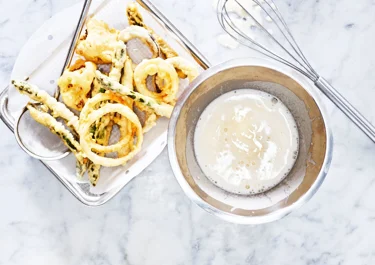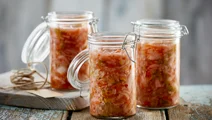Tempura vegetables

Tempura vegetables are crisp, fresh, and flavourful vegetables covered in a classic tempura batter, deep-fried to golden brown and crispy perfection. The Japanese dish is made by lightly battering and deep-frying vegetables. It is a great appetiser, side dish, or snack that brings out the natural flavours of the vegetables with an extra crunchy bite. Give it a try and savour the delights of tender and crispy textures!
Ingredients
|
Wheat flour (approx. 1 dl)
|
60 g |
|---|---|
|
Corn flour (approx. 1 dl)
|
50 g |
|
Baking powder
|
1 tsp |
|
Fine salt
|
½ tsp |
|
Beer or water
|
100 ml |
|
Egg
|
1 |
|
Oil for frying, for example, rapeseed oil (not cold pressed)
|
½ l |
|
Mixed vegetables, for example, cauliflower florets, onion rings, zucchini in slices, and green asparagus
|
400 g |
Instructions
Recommended information
Serving suggestion
Tips
When making tempura batter, you can use either water or beer. Water is a common choice that helps create a thin and delicate batter. However, making tempura batter with beer is also a great option as it contains carbon dioxide, which helps create a light and crispy texture. Club soda produces a similar effect, as the carbonation creates air pockets in the batter, resulting in a lighter and crisper coating. Whether you opt for water, beer, or club soda, the key is to use a cold liquid to keep the coating light and crispy.
Tips
Another important tip is to prep the vegetables before battering and frying them. This means washing and drying them thoroughly and cutting them into bite-sized pieces. While an assortment of vegetables is good for frying, tougher vegetables like sweet potatoes, carrots, and winter squash should be parboiled first and cooled before frying. This will help ensure that they cook evenly and that the tempura batter stays crispy.
Tips
Lastly, it is important to fry the vegetables at the right temperature. The ideal temperature for frying tempura vegetables is between 170-180°C. If the oil is too hot, the batter will burn and take on a bitter taste, and if the oil is not hot enough, the vegetables will absorb too much oil and become greasy and soggy.
Questions about tempura
Tempura is a delicious Japanese deep-fried dish and we opted for a version with vegetables covered in tempura batter. If you want to know more about this tasty dish, keep on reading below.
What is tempura?
Tempura is a Japanese dish that consists of battered and deep-fried seafood, vegetables, or other ingredients. The batter for tempura is usually made from a mixture of wheat flour, eggs, and water (and sometimes also cornflour and baking powder), which is then coated onto the ingredients before frying. The result is a crispy and light exterior that contrasts well with the soft and tender texture of the cooked vegetable, meat, or seafood on the inside. It is typically served with a dipping sauce called tentsuyu, which is made from a mixture of dashi (a Japanese soup stock), soy sauce, and mirin (a sweet rice wine), but most dipping sauces with Japanese flavours are perfect for tempura vegetables.
How to make tempura batter?
To make tempura batter, mix flour, cornflour, baking powder, and salt in a bowl. Add half of the liquid and whisk until the batter is smooth. Then, add the rest of the liquid and an egg and whisk until light and airy. Heat oil to 180°C in a small saucepan. Dip vegetables into the batter and fry in the oil for approx. 3 minutes or until golden. Place the fried tempura vegetables on oil-absorbent paper to soak up excess oil. Sprinkle with flake salt and serve right away.
How long does tempura batter last?
Tempura batter is best used immediately after it is prepared. However, if you have leftover batter, you can store it in the refrigerator for 2-3 days. It is important to keep the batter in an airtight container and to use it as soon as possible to get the best taste and texture.
Can you freeze tempura batter?
You can freeze the tempura batter for up to 1 month. To do so, pour the batter into an airtight container suited for the freezer, but leave enough space at the top, as the batter will expand once it freezes. Additionally, you can place a piece of cling film on top of the tempura batter to prevent any skin from forming. Finally, seal the container and place it in the freezer.
What to serve with tempura?
Tempura vegetables can be served with a variety of accompaniments. Some popular options include dipping sauces like tentsuyu, soy sauce, or ponzu, as well as sides like steamed rice, miso soup, pickled vegetables, salad, and soba noodles. With so many options to choose from, it is easy to find a combination that will satisfy your palate.
What makes tempura batter different from normal batter?
Tempura batter is different from normal batter in several ways. First, it uses a combination of wheat flour and cornflour instead of just wheat flour, which leads to a lighter and crispier texture. Additionally, tempura batter is mixed with either water or beer, creating a bubbly and airy texture when fried. Overall, the batter yields a more delicate, crispy result than conventional batter.
How to keep tempura crispy?
Make sure that your ingredients are chilled before you start. Cold ingredients will help to keep the batter crispy. When you are ready to fry the tempura vegetables, heat the oil to 180°C. It is important to fry the battered vegetables in small batches to prevent the oil temperature from dropping, resulting in soggy tempura vegetables. Once it is cooked, use a slotted spoon or wire mesh strainer to remove the vegetables from the oil and place them on paper towels to drain excess oil. Serve the tempura vegetables immediately after frying while they are still hot and crispy.
Nutritional values
Nutritional value, per
4573 Kcal
| Fibre | 19.8 gram fibers |
| Protein | 32 gram |
| Carbohydrates | 92.3 gram |
| Fat | 460 gram |
Tempura vegetables using all your favourite vegetables
Tempura vegetables are traditional in ancient Japanese cuisine. It involves coating vegetables in a light batter and deep-frying them until they are crispy and golden brown. One of the great things about tempura vegetables is that you can use all your favourite vegetables, such as zucchini, mushrooms, broccoli, and onions. In Japan, tempura is typically made using seasonal vegetables such as eggplant, sweet potato, pumpkin, and bell pepper, but you can use whatever you like the most. The batter for tempura provides a light, crispy coating that perfectly complements the natural flavours of the vegetables, making for an irresistible snack or side dish.
Onion rings, green beans, cauliflower, broccoli, and other classics
Our recipe for vegetable tempura uses onion rings, green beans, cauliflower, broccoli, and other delicious classics that are well-suited for deep-frying due to their texture and flavour. Because these vegetables have a relatively low water content along with a firm texture, they are ideal for deep-frying. While the batter itself is relatively mild in flavour, it serves as the perfect canvas for highlighting the natural flavours of the vegetables. Once fried, the tempura batter helps create a crispy and crunchy shell that complements the natural sweetness and savoury flavours of the vegetables wonderfully.
Make a crispy meal with homemade tempura batter
The homemade batter used in tempura recipes is one of the key components that make this dish so special. It is light and airy, which yields a perfect counterpoint to the tender vegetables once they are fried.
The key to achieving a light and crispy Japanese tempura batter is to mix the ingredients just enough to form a smooth, lump-free batter but not so much that it becomes dense and heavy. The combination of delicate flavours from the vegetables and the satisfying crunch from the tempura batter is the reason tempura vegetables are enjoyed by so many people around the world.
If you are in the mood for more crispy fried dishes, be sure to check out our recipes for chicken nuggets and classic fish and chips.
How to serve tempura vegetables
Tempura vegetables are both versatile and delicious and can be served in a variety of ways. One popular way is as an appetiser or a light snack along with a dipping sauce, such as soy sauce or a classic tentsuyu sauce, to enhance the flavour of the fried vegetables. Alternatively, tempura vegetables can be served as a side dish to a main course, such as a Japanese-style meal of rice and miso soup. Finally, you can enjoy the dish with noodles, such as soba or udon, for a hearty and satisfying meal. Regardless of how you choose to serve them, tempura vegetables are a crispy and flavourful dish that is sure to satisfy your craving for something fried and delicious.
Experiment with a dipping sauce
Experimenting with dipping sauces for tempura vegetables is a great way to take this already-delicious dish to the next level. While a traditional tempura dipping sauce is made from soy sauce, mirin, and dashi, many other sauces can be used to enhance the flavour of your battered and deep-fried vegetables.
One option is to try a spicy dipping sauce made by combining soy sauce, rice vinegar, chilli paste, and honey. The sweet and spicy flavour will provide a delicious contrast to the crispy tempura vegetables.
You can also experiment with fruit-based dipping sauces. A mango dipping sauce, for example, can be made by mixing mango purée, rice vinegar, and a little bit of sugar. The fruity sweetness of the sauce will complement the crispy, savoury tempura vegetables perfectly and add a burst of freshness to the dish.
If you are feeling adventurous, you can even try a savoury peanut dipping sauce. This sauce can be made by combining peanut butter, soy sauce, lime juice, honey, and chilli flakes.








